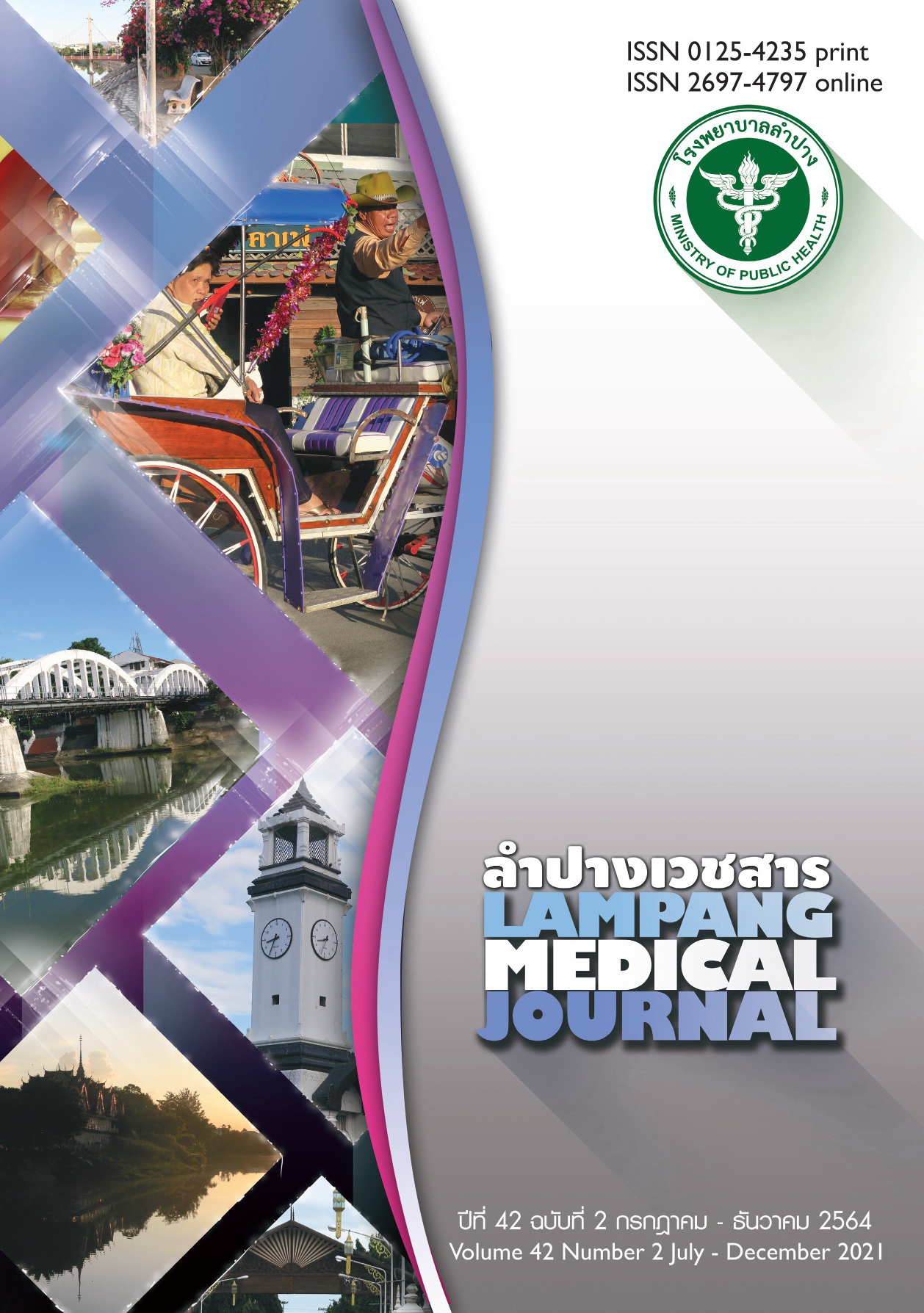Comparison of Hematocrit and Serum Microbilirubin at 48 Hours of Age between Umbilical Cord Milking versus Early Cord Clamping in Term Neonates Delivered by Cesarean Section
Main Article Content
Abstract
Background: Umbilical cord milking (UCM), in which cord blood is milked toward the baby, has been used to prevent anemia in infants with vaginal delivery. Its benefit compared with early cord clamping (ECC), in which the umbilical cord is clamped at 30 seconds after birth, in full-term neonates delivered by cesarean section is lacking.
Objective: To investigate the effect of UCM compared with 30-seconds ECC on hematocrit (Hct) and serum microbilirubin at 48 hours of age among term neonates delivered by cesarean section.
Materials and methods: A retrospective cohort study was conducted among 206 full-term neonates delivered by cesarean section in San Sai Community Hospital between October 2020 and January 2021. The cord of the UCM group was milked 3 times after cutting and clamping at 25 cm from the umbilicus, whereas in ECC group cord was clamped at 2-3 cm near the umbilicus
and not milked. Both groups received similar routine care. Hct and serum microbilirubin were measured at 48 hours of age. Percentages of infants with anemia (Hct <45%) and polycythemia (Hct >65%) were calculated. Student t-test and Fisher’s exact test were used for statistical analysis.
Results: There were 96 neonates in UCM group and 110 in ECC group. In UCM group, the average maternal age was significant higher and the mean gestational age was significant lower than those of ECC group. Hct level at 48 hours in UCM group was significant higher than the ECC group (50.4 ± 6.5% vs 48.3 ± 5.9%, p=0.016), but the microbilirubin level was not different (9.4 ± 2.1
vs 9.2 ± 2.1 mg/dl, p=0.505). Percentages of infants with anemia was slightly lower in the UCM group than the ECC group (17.7% vs 23.6%, p=0.309). No significant differences in percentages of infants with polycythemia or receiving phototherapy were found.
Conclusion: Umbilical cord milking in term neonates delivered by cesarean section could significantly increase the hematocrit level at 48 hours of age and trended to lower the percentage of infants with anemia, comparing with the early cord clamping method.
Article Details

This work is licensed under a Creative Commons Attribution-NonCommercial-NoDerivatives 4.0 International License.
บทความที่ส่งมาลงพิมพ์ต้องไม่เคยพิมพ์หรือกำลังได้รับการพิจารณาตีพิมพ์ในวารสารอื่น เนื้อหาในบทความต้องเป็นผลงานของผู้นิพนธ์เอง ไม่ได้ลอกเลียนหรือตัดทอนจากบทความอื่น โดยไม่ได้รับอนุญาตหรือไม่ได้อ้างอิงอย่างเหมาะสม การแก้ไขหรือให้ข้อมูลเพิ่มเติมแก่กองบรรณาธิการ จะต้องเสร็จสิ้นเป็นที่เรียบร้อยก่อนจะได้รับพิจารณาตีพิมพ์ และบทความที่ตีพิมพ์แล้วเป็นสมบัติ ของลำปางเวชสาร
References
คณะอนุกรรมการมาตรฐานวิชาชีพ ราชวิทยาลัยสูตินรีแพทย์แห่งประเทศไทย. ความรู้เรื่องการผ่าท้องทำคลอด (Cesarean Section) สำหรับผู้รับบริการ.ใน: ฐิติมา สุนทรสัจ บรรณาธิการ. แนวทางเวชปฏิบัติของราชวิทยาลัยสูตินรีแพทย์แห่งประเทศไทย พ.ศ.2550-2555.กรุงเทพฯ: ทรี-ดี สแกน;2555. หน้า 315-27.
อรุณี เจตศรีสุภาพ, ผกาพรรณ เกียรติชูสกุล, พัชรี คำวิลัยศักดิ์. ความผิดปรกติทางโลหิตวิทยา.ใน: สุกัญญา ทักษพันธุ์ บรรณาธิการ. คู่มือทารกแรกเกิด.
พิมพ์ครั้งที่ 3. ขอนแก่น:คลังนานาวิทยา;2545.หน้า 159-84.
Annoppornchai D, Prachukthum S, Kositamongkol S. Prevalence of neonatal anemia in well-appearing term neonates running head: prevalence of anemia in healthy term neonates. Thammasat Med J. 2019;19(3):519-24.
Committee on Obstetric Practice, American College of Obstetricians and Gynecologists. Committee Opinion No.543: Timing of umbilical
cord clamping after birth. Obstet Gynecol. 2012;120 (6):1522-6.
Upadhyay A, Gothwal S, Parihar R, Garg A, Gupta A, Chawla D, et al. Effect of umbilical cord milking in term and near-term infants: randomized control trial. Am J Obstet Gynecol. 2013;208(2):120e121-6.
Panburana P, Odthon T, Pongmee, Hansahiranwadee W. The effect of umbilical cord milking compared with delayed cord clamping in term neonates: a randomized controlled trial. Int J Womens Health. 2020;12:301–6.
Erickson-Owens DA, Mercer JS, Oh W. Umbilical cord milking in term infants delivered by cesarean section: a randomized controlled trial. J Perinatol. 2012;32(8):580–4.
World Health Organization. Guideline: Delayed umbilical cord clamping for improved maternal and infant health and nutrition outcomes. Geneva: WHO; 2014.
Katharina AC. Umbilical cord milking: a review. Front Pediatr. 2018;6:1-4.
Committee on Obstetric Practice, American College of Obstetricians and Gynecologists. Committee Opinion No.684: Delayed umbilical cord clamping after birth. Obstet Gynecol. 2017;129(1):e5–10.
Tipwaree S, Somprasit C, Tanprasertkul C, Bhamarapravatana K, Suwannarurk K. The effect of umbilical cord clamping, cutting and milking in term infants delivered by Cesarean section: a randomized controlled trial. Thai J Obstet Gynaecol. 2017;25(1):35-43.
Vincenzo Z, Pietro G, Lorenzo S, Alphonse S, Matteo P, Gianluca S. A randomized controlled trial of intact cord milking versus immediate cord clamping in term infants born by elective cesarean section. Am J Perinatol. 2021;38(4):392-7.
Shukla AK, Srivastava S, Verma G. Effect of maternal anemia on the status of iron stores in infants: A cohort study. J Family Community Med. 2019;26(2):118-22.


